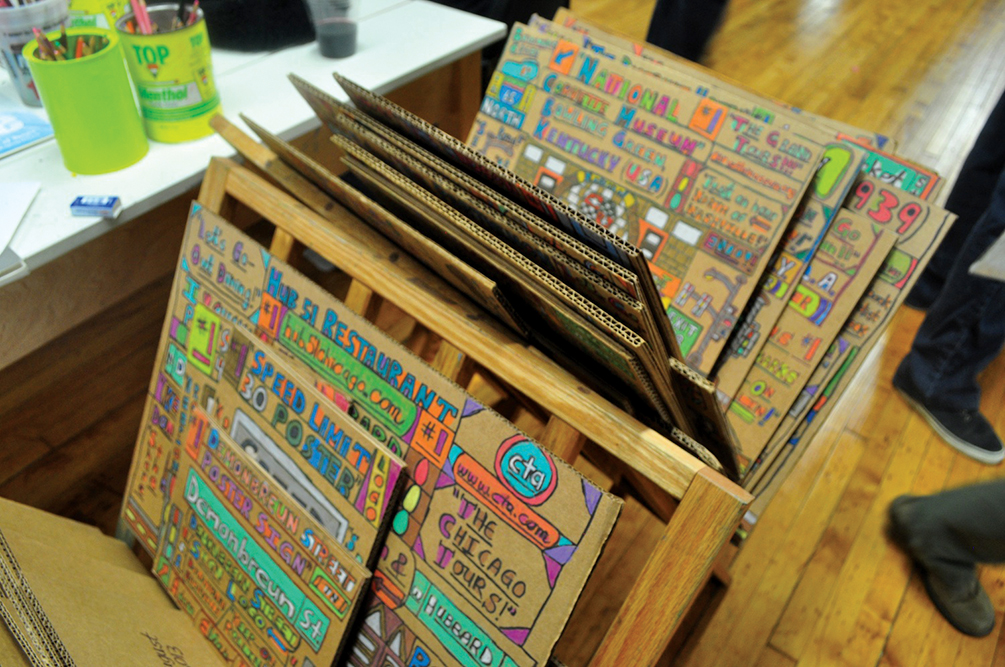
Christina Milian is staring at me. She smiles coyly, framed in a frayed, six-by-six square of cardboard. Next to her is Snooki, and next to Snooki is Rosario Dawson. Below each of them is a sticker with their names, along with, “Andrew Hall. 50.00.” Hall himself is standing next to me, pointing at each portrait in turn, smiling. “These ones are mine.”
We are standing in the gallery space of Project Onward in the Bridgeport Art Center, where the Eleventh Annual Cardboard Show is taking place. Project Onward has been in the space since this past July, and it would have been easy to miss the entrance if not for the brightly decorated cardboard signs pointing the way. Following the signs through narrow hallways, I took one final turn and found myself in the artists’ studio: white-walled, wood-floored, the foreground teeming with glitter and cardboard, the background buzzing with people. After the cramped hallways it seemed endless.
I ran into Hall as I began to make my way through the artists’ workspaces and display boards toward the gallery. Hall is one of Project Onward’s most popular artists. Several of his pieces—detailed renderings of churches and building facades—hang in the conference room off of the main studio. He has been in the program for nine years, starting soon after it was established in 2004. Originally, Project Onward was an outgrowth of Gallery 37, an organization that allows students ages fourteen through twenty-one to apprentice with Chicago artists. The students aging out of Gallery 37 could continue their interests with Project Onward. It grew so quickly that in summer of 2005, the organization moved to the second floor (and, in 2008, a portion of the first floor) of the Chicago Cultural Center.
Project Onward’s primary aim is to provide artistic guidance for artists with mental illnesses and developmental disabilities. They currently have forty member artists, all of whom work two to five days a week in their new studio space in Bridgeport. Jackson cites the new, independent non-profit status of the program as a major reason for the move. “We wanted to keep our integrity,” he says. Moving to a new neighborhood from the Loop was a major factor in establishing the organization as an independent gallery and studio space.
Communications Director Rachael Zuppke agrees. “That part of the city, it’s just a restriction to growth. Here, we have room to expand.” The Cultural Center as a tourist destination, she says, was a boon in terms of the sheer number of visitors, but the move to Bridgeport allows the program to make its own way in the Chicago arts world. “It’s great having a space like this,” she says, referring to the Bridgeport Art Center, a building specifically designed for the arts. “Back at the Cultural Center, for example, we had this one blue wall that was really poorly-lit. It’s just hard to take that seriously sometimes.” All around her, the walls shine a bright white.
About halfway through the show, I found the Cardboard Show’s organizer, Mike Pocius. Mike’s brother Allan began the Annual Cardboard Show back in 2002 in his apartment, and a few years later Mike took over. The show is a neighborhood tradition that has popped up in venues all over Bridgeport. The Cardboard Show found its way to Project Onward’s space in part because of Pocius’s volunteering for the program, back in its Cultural Center days.
Jackson says that Pocius was the one who introduced cardboard to Project Onward artists. “I was the Cardboard Guy,” Pocius confirms. “Saved them a whole lot of money on canvas. Especially with Adam Hines.” He points at a tall stack of paintings nearby. “He’s got something like 6,000 pieces on cardboard. Yeah,” he says, seeing my face. “A lot of money.” Cardboard’s ubiquity and sturdiness provide the artists with plenty of material for their projects, and it is visible on every work surface.
Cobalt Studio in Bridgeport, host of the 2012 Cardboard Show and Pocius’s own photography, refers to Pocius as the “King of the Chicago Street Photographers.” He has a strong Chicago accent and a deep appreciation for his hometown and its residents. One way he shows this is in the central tenet of the Cardboard Show: it is open to all, and no artist is turned away.
Thanks to the lack of restrictions, the variety within the show is pretty incredible: much of the cardboard serves as a surface for paint or colored pencils, as well as providing mounting material, but there are sculptures and reliefs that show off its versatility as medium. A cardboard koi fish moves through waves of corrugated brown. A tiny cardboard man vomits on a sidewalk outside of a foreshortened sculpture of a building. The sold pieces are accompanied by red dots, and the gallery’s white walls are already adorned with a generous spray of these dots. The Cardboard Show usually runs for about three days, but it will be up in the Project Onward gallery until November 27.
At nine o’clock there is a raffle. I hold my ticket, listen to the numbers, and watch as Zuppke and a middle-aged attendee step forward to light applause and cheers. They receive glittery cardboard crowns and pose for pictures. Zuppke is laughing, and her crown sparkles in the gallery lights. The crowd shuffles around for a better look. The newly anointed Cardboard Royalty put their arms over each other’s shoulders, and when I look around, everyone is smiling. A change in venue often stirs up myriad problems, but Project Onward still maintains their mission. Jackson mentioned earlier that not one artist was lost during the transition to Bridgeport. Project Onward may still be settling into their new home, but they sure do look comfortable.
Bridgeport Art Center, 1200 W. 35th Street. Through November 27. Monday-Saturday, 8am-6pm; Sunday, 8am-noon. Free. (773)247-3000. bridgeportart.com
